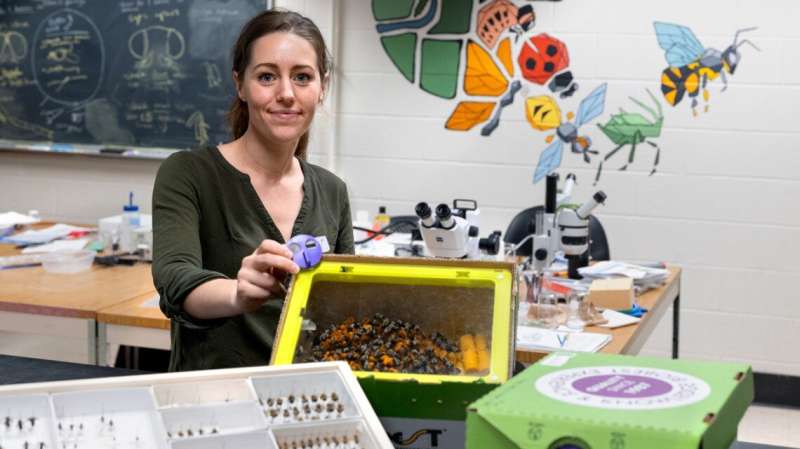This article has been reviewed according to Science X's editorial process and policies. Editors have highlighted the following attributes while ensuring the content's credibility:
fact-checked
peer-reviewed publication
trusted source
proofread
Bumblebee research sparks rapid industry change

A Cornell study that revealed commercial eastern common bumblebee hives pose a threat to their wild counterparts has led one major pollination company to quickly adapt the bumblebee hive boxes they ship to growers.
The study, which was published in February in the Journal of Applied Ecology, showed that brightly colored commercial bumblebee nest boxes attract wild queens, who may be seeking to establish their own nests. When wild queens enter these nest boxes, workers treat them as invaders and kill them, which causes losses of wild hives—and valuable pollinators—in those areas.
The study also found that attaching an existing device—called an excluder—to the nest box doorways, was 100% effective at preventing wild queens from entering hives.
The company, Plant Products, a North American subsidiary of Biobest, has already provided excluders for the entrances and exits of all hives it ships, along with excluder operating instructions. In addition, a product manager has called every client to explain the use of the excluder, which makes a doorway too small for large queens, but big enough for workers.
"For every queen that we're losing because of this behavior, that's a whole colony of bumblebees that we're potentially losing that's providing really important pollination services later in the season," said Heather Grab, Ph.D. '17, senior lecturer in the School of Integrative Plant Science in the College of Agriculture and Life Sciences, and the paper's corresponding author. Olivia Miller '21, who worked on this research as part of her undergraduate thesis, is the paper's first author.
"From what we see in our data, it's an average of about 10 queens per colony that are being killed, and that's just in our study region," she added.
The study also found that pollination services actually declined at sites where commercial bumblebee colonies were used, compared to areas where they were not used. The scientists suspect that the drop in services was due to the loss of wild pollinators.
A few months prior to the paper's publication, co-author Scott McArt, Ph.D. '12, associate professor of pollinator health in the Department of Entomology (CALS) and manager of the Dyce Lab for Honeybee Studies, contacted Plant Products and Koppert, the only two North American commercial bumblebee suppliers, to tell them about their findings and how excluders offer a simple and effective solution. By the time the paper published in February, Plant Products was already prepared to add excluders to all its shipments. The company has also started research and development to evaluate optimal strategies going forward.
"Frankly, I've been blown away by how quickly Biobest responded to the study's findings and implemented simple but effective companywide changes," McArt said.
The excluders were originally developed for a completely different purpose, but came in handy when the Cornell researchers made their discovery. Commercial bumblebee nest boxes come with two openings, which serve as an entrance and an exit for the bees. The openings can be slid shut, so if growers spray their crops, they can close the exit to keep bees in but leave the entrance open for bees out foraging to return. Also, if growers want to move a hive, they can close both openings and reopen them in a new location.
Excluders were originally developed to cover just the exit, to prevent commercial hive queens from escaping and mating with wild bees and mixing genes, and/or spreading disease. No one expected they would be needed to keep wild bees out. Now Plant Products is using the excluders on both the entrances.
Overall, bumblebees have been experiencing population declines throughout North America, so saving queens early in spring has a high potential to stem some of those declines, McArt added.
Journal information: Journal of Applied Ecology
Provided by Cornell University



















